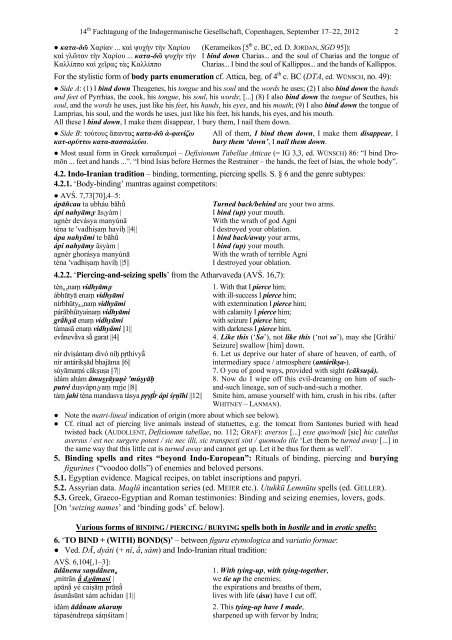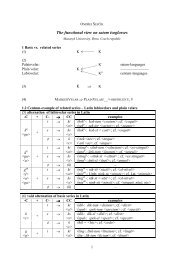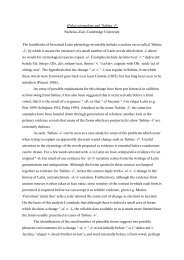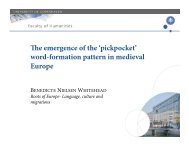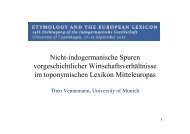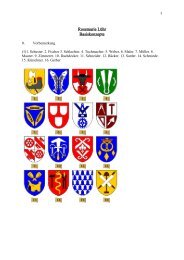Roots Deep in Heaven Indo-Iranian ritual concepts in a cross ...
Roots Deep in Heaven Indo-Iranian ritual concepts in a cross ...
Roots Deep in Heaven Indo-Iranian ritual concepts in a cross ...
You also want an ePaper? Increase the reach of your titles
YUMPU automatically turns print PDFs into web optimized ePapers that Google loves.
14 th Fachtagung of the <strong>Indo</strong>germanische Gesellschaft, Copenhagen, September 17–22, 2012 2<br />
● κατα-δῶ Χαρίαν ... καὶ ψυχὴν τὴν Χαρίου<br />
καὶ γλῶταν τὴν Χαρίου ... κατα-δῶ ψυχὴν τὴν<br />
Καλλίππο καὶ χεῖρας τὰς Καλλίππο<br />
(Kerameikos [5 th c. BC, ed. D. JORDAN, SGD 95]):<br />
I b<strong>in</strong>d down Charias... and the soul of Charias and the tongue of<br />
Charias... I b<strong>in</strong>d the soul of Kallippos... and the hands of Kallippos.<br />
For the stylistic form of body parts enumeration cf. Attica, beg. of 4 th c. BC (DTA, ed. WÜNSCH, no. 49):<br />
● Side A: (1) I b<strong>in</strong>d down Theagenes, his tongue and his soul and the words he uses; (2) I also b<strong>in</strong>d down the hands<br />
and feet of Pyrrhias, the cook, his tongue, his soul, his words; [...] (8) I also b<strong>in</strong>d down the tongue of Seuthes, his<br />
soul, and the words he uses, just like his feet, his hands, his eyes, and his mouth; (9) I also b<strong>in</strong>d down the tongue of<br />
Lamprias, his soul, and the words he uses, just like his feet, his hands, his eyes, and his mouth.<br />
All these I b<strong>in</strong>d down, I make them disappear, 1 bury them, I nail them down.<br />
● Side B: τούτους ἅπαντας κατα-δῶ ἀ-φανίζω<br />
κατ-ορύττω κατα-πασσαλεύω.<br />
All of them, I b<strong>in</strong>d them down, I make them disappear, I<br />
bury them ‘down’, I nail them down.<br />
● Most usual form <strong>in</strong> Greek καταδεσμοί – Defixionum Tabellae Atticae (= IG 3,3, ed. WÜNSCH) 86: “I b<strong>in</strong>d Dromōn<br />
... feet and hands ...”. “I b<strong>in</strong>d Isias before Hermes the Restra<strong>in</strong>er – the hands, the feet of Isias, the whole body”.<br />
4.2. <strong>Indo</strong>-<strong>Iranian</strong> tradition – b<strong>in</strong>d<strong>in</strong>g, torment<strong>in</strong>g, pierc<strong>in</strong>g spells. S. § 6 and the genre subtypes:<br />
4.2.1. ‘Body-b<strong>in</strong>d<strong>in</strong>g’ mantras aga<strong>in</strong>st competitors:<br />
́<br />
́<br />
● AVŚ. 7,73[70],4–5:<br />
ápāñcau ta ubháu bāhū<br />
Turned back/beh<strong>in</strong>d are your two arms.<br />
ápi nahyāmiy āsíyàm |<br />
I b<strong>in</strong>d (up) your mouth.<br />
agnér devásya manyúnā<br />
With the wrath of god Agni<br />
téna te ʹvadhiṣaṃ havíḥ ||4||<br />
I destroyed your oblation.<br />
ápa nahyāmi te bāhū<br />
I b<strong>in</strong>d back/away your arms,<br />
ápi nahyāmy āsyàm |<br />
I b<strong>in</strong>d (up) your mouth.<br />
agnér ghorásya manyúnā<br />
With the wrath of terrible Agni<br />
téna ʹvadhiṣaṃ havíḥ ||5||<br />
I destroyed your oblation.<br />
4.2.2. ‘Pierc<strong>in</strong>g-and-seiz<strong>in</strong>g spells’ from the Atharvaveda (AVŚ. 16,7):<br />
téna enaṃ vidhyāmiy<br />
ábhūtyā enaṃ vidhyāmi<br />
nírbhūtyā enaṃ vidhyāmi<br />
párābhūtya<strong>in</strong>aṃ vidhyāmi<br />
grā́ hiyā enaṃ vidhyāmi<br />
támasā enaṃ vidhyāmi ||1||<br />
evā́nevā́va sā<br />
1. With that I pierce him;<br />
with ill-success I pierce him;<br />
with exterm<strong>in</strong>ation I pierce him;<br />
with calamity I pierce him;<br />
with seizure I pierce him;<br />
with darkness I pierce him.<br />
́ garat ||4|| 4. Like this (‘So’), not like this (‘not so’), may she [Grāhi/<br />
Seizure] swallow [him] down.<br />
nír dviṣántaṃ divó níḥ pr̥ thivyā ́<br />
6. Let us deprive our hater of share of heaven, of earth, of<br />
nír antárikṣād bhajāma ||6||<br />
<strong>in</strong>termediary space / atmosphere (antárikṣa-).<br />
súyāmaṃś cākṣuṣa ||7|| 7. O you of good ways, provided with sight (cāksuṣá).<br />
idám ahám āmuṣyāyaṇè 'múṣyāḥ<br />
8. Now do I wipe off this evil-dream<strong>in</strong>g on him of such-<br />
putré duṣvápniyaṃ mr̥ je ||8||<br />
and-such l<strong>in</strong>eage, son of such-and-such a mother.<br />
táṃ jahi téna mandasva tásya pr̥ ṣṭī́r ápi śr̥ ṇīhi ||12|| Smite him, amuse yourself with him, crush <strong>in</strong> his ribs. (after<br />
WHITNEY – LANMAN).<br />
● Note the matri-l<strong>in</strong>eal <strong>in</strong>dication of orig<strong>in</strong> (more about which see below).<br />
● Cf. <strong>ritual</strong> act of pierc<strong>in</strong>g live animals <strong>in</strong>stead of statuettes, e.g. the tomcat from Santones buried with head<br />
twisted back (AUDOLLENT, Defixionum tabellae, no. 112; GRAF): aversos [...] esse quo/modi [sic] hic catellus<br />
aversus / est nec surgere potest / sic nec illi, sic transpecti s<strong>in</strong>t / quomodo ille ‘Let them be turned away [...] <strong>in</strong><br />
the same way that this little cat is turned away and cannot get up. Let it be thus for them as well’.<br />
5. B<strong>in</strong>d<strong>in</strong>g spells and rites “beyond <strong>Indo</strong>-European”: Rituals of b<strong>in</strong>d<strong>in</strong>g, pierc<strong>in</strong>g and bury<strong>in</strong>g<br />
figur<strong>in</strong>es (“voodoo dolls”) of enemies and beloved persons.<br />
5.1. Egyptian evidence. Magical recipes, on tablet <strong>in</strong>scriptions and papyri.<br />
5.2. Assyrian data. Maqlû <strong>in</strong>cantation series (ed. MEIER etc.). Utukkū Lemnūtu spells (ed. GELLER).<br />
5.3. Greek, Graeco-Egyptian and Roman testimonies: B<strong>in</strong>d<strong>in</strong>g and seiz<strong>in</strong>g enemies, lovers, gods.<br />
[On ‘seiz<strong>in</strong>g names’ and ‘b<strong>in</strong>d<strong>in</strong>g gods’ cf. below].<br />
Various forms of BINDING / PIERCING / BURYING spells both <strong>in</strong> hostile and <strong>in</strong> erotic spells:<br />
6. ‘TO BIND + (WITH) BOND(S)’ – between figura etymologica and variatio formae:<br />
● Ved. DĀ, dyáti (+ ní, ā́ , sám) and <strong>Indo</strong>-<strong>Iranian</strong> <strong>ritual</strong> tradition:<br />
AVŚ. 6,104[,1–3]:<br />
ādā́ nena saṃdā́ nena<br />
amítrān ā ́ diyāmasi |<br />
apānā ́ yé caiṣāṃ prāṇā ́<br />
ásunā́sūnt sám achidan ||1||<br />
idám ādā́ nam akaraṃ<br />
tápaséndreṇa sáṃśitam |<br />
1. With ty<strong>in</strong>g-up, with ty<strong>in</strong>g-together,<br />
we tie up the enemies;<br />
the expirations and breaths of them,<br />
lives with life (ásu) have I cut off.<br />
2. This ty<strong>in</strong>g-up have I made,<br />
sharpened up with fervor by Indra;


